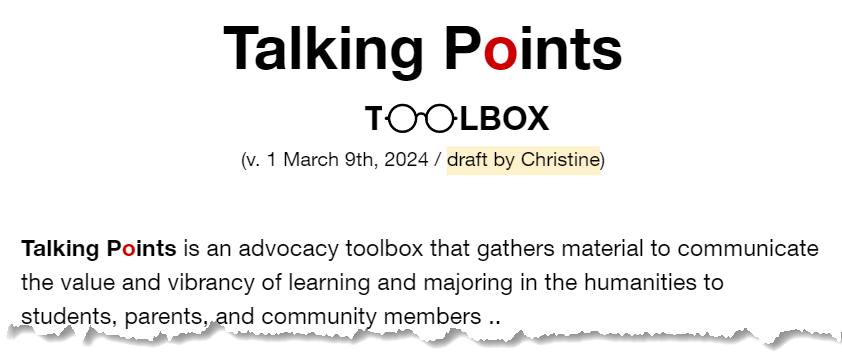The following are early plans from the Center for Humanities Communication (CHC) for developing a Humanities Communication Digital Interchange (HumSource) providing open access to excellent examples of humanities communication — ideas, explanations, stories, and multimedia — along with resources and tools to facilitate their collaborative creation. The goal of the interchange is to enable humanities organizations and projects, both large and small, to assist each other in communicating the humanities.The HumSource interchange would be a growing, sustainable digital repository of humanities advocacy and communication outputs, resources, and tools built on open-access and FAIR (findable, accessible, interoperable, and reusable) principles. Its framework will be implemented through standards, templates, linked open data, or other means allowing for federated data adoption and customization by humanities-serving organizations or individuals. Ideally, the interchange could be co-developed with or could extend other open, federated, or linked-data humanities and cultural heritage platforms such as Knowledge Commons (formerly Humanities Commons), Digital Public Library of America, and HuNI.
Outputs
What are the most important kinds of output – of content, form, and media – that could be developed for humanities communication?
Outputs to be featured in the HumSource interchange might include the kinds of materials that the CHC has begun gathering as “talking points” for the humanities. Among exemplary humanities communication outputs will be some historical humanities communication materials drawn from various ages in the past through the 1960s when the National Endowment for the Humanities (and the National Endowment for the Arts) were established.
— Examples of Talking Point Materials —
“Talking Points Toolbox” concept being developed by Christine Henseler for the Center for Humanities Communication (see proposal).


Menu panel in the Center for Humanities Communication’s Bibliography showing “Talking Points on the Humanities: Definitions, Values, Contributions.” (This section of the CHC Bibliography will in the future be synchronized with the categories and resources in the CHC “Talking Points Toolbox.”
Resources
What resources can be collaboratively curated and shared by humanities organizations and others as building blocks or input for enhanced public communication of the humanities?
The HumSource interchange will develop shared collections of resource materials that can be used by humanities organizations, projects, and individuals to help build effective humanities communication outputs. Such materials would include: examples, data, evidence, stories, multimedia, metaphors, and others.
Tools
What open tools and platforms can boost the work of creating effective humanities communication?
Based on the successful precedent of such open platforms designed for humanities work as Knowledge Commons (previously Humanities Commons) and Manifold, the CHC forsees that similarly open, non-proprietary tools and platforms will need to be developed in the next ten years for humanities communication. HumSource would be an interchange for sharing, and helping build a critical mass of users for, such tools and platforms.
For example, an especially high priority in the near future will be to develop or adopt for the humanities open tools and platforms for ➤ collaborative content and media design, ➤ team communication, and ➤ project management that could be analogous to such widely-used proprietary platforms in the commercial and start-up sectors as Figma, Airtable, Slack, and others. (The subscription costs of such platforms for more than a few participants at a time makes them unsustainable for any but the best funded humanities initiatives and organizations.)
Another high priority is to develop for the humanities “fine-tuned” Large Language Models (LLMs) customized for the humanities in a manner analogous to the way some universities have created customized LLMs for themselves (e.g., University of Michigan’s U-M GPT) or that users can take advantage of Google’s NotebookLM to ask AI to summarize or analyze a set of custom texts. Such humanities LLMs would be trained on humanities materials and oriented toward suggesting, improving, or otherwise facilitating fluency in a kind of “mediating” discourse bridging between humanities scholarship and the public.
Such AI could watch over the shoulder of people working in the humanities to suggest how the materials they create in the ordinary course of scholarship, teaching, events, and so on might be extracted and summarized (and edited further by humans) for effective public communication. Sometimes there is wonderful public humanities content buried deep in a research article or class lesson plan. How wonderful would it be if AI could be prompted to provide summaries and other outputs, which might then in turn prompt busy humanists–now that a first draft press release, blog post, or social media post has been easily created–to finish the job of public communication through relatively light revisions and additions.
